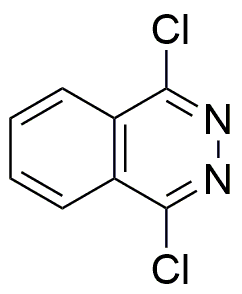1,4-Dichlorophthalazine is widely utilized in research focused on:
- Pharmaceutical Development: This compound serves as a key intermediate in the synthesis of various pharmaceutical agents, particularly those targeting neurological disorders, enhancing drug efficacy and specificity.
- Organic Synthesis: It is used in the production of complex organic molecules, allowing chemists to create diverse compounds with potential applications in materials science and nanotechnology.
- Analytical Chemistry: 1,4-Dichlorophthalazine acts as a reagent in analytical methods, enabling the detection and quantification of other chemical substances, which is crucial for quality control in manufacturing.
- Research in Material Sciences: The compound is explored for its properties in developing new materials, such as polymers and coatings, which can offer improved durability and performance in various applications.
- Environmental Studies: It is utilized in studies assessing the environmental impact of chlorinated compounds, helping researchers understand degradation pathways and toxicity levels, which is vital for regulatory compliance.
General Information
Properties
Safety and Regulations
Applications
1,4-Dichlorophthalazine is widely utilized in research focused on:
- Pharmaceutical Development: This compound serves as a key intermediate in the synthesis of various pharmaceutical agents, particularly those targeting neurological disorders, enhancing drug efficacy and specificity.
- Organic Synthesis: It is used in the production of complex organic molecules, allowing chemists to create diverse compounds with potential applications in materials science and nanotechnology.
- Analytical Chemistry: 1,4-Dichlorophthalazine acts as a reagent in analytical methods, enabling the detection and quantification of other chemical substances, which is crucial for quality control in manufacturing.
- Research in Material Sciences: The compound is explored for its properties in developing new materials, such as polymers and coatings, which can offer improved durability and performance in various applications.
- Environmental Studies: It is utilized in studies assessing the environmental impact of chlorinated compounds, helping researchers understand degradation pathways and toxicity levels, which is vital for regulatory compliance.
Documents
Safety Data Sheets (SDS)
The SDS provides comprehensive safety information on handling, storage, and disposal of the product.
Product Specification (PS)
The PS provides a comprehensive breakdown of the product’s properties, including chemical composition, physical state, purity, and storage requirements. It also details acceptable quality ranges and the product's intended applications.
Certificates of Analysis (COA)
Search for Certificates of Analysis (COA) by entering the products Lot Number. Lot and Batch Numbers can be found on a product’s label following the words ‘Lot’ or ‘Batch’.
*Catalog Number
*Lot Number
Certificates Of Origin (COO)
This COO confirms the country where the product was manufactured, and also details the materials and components used in it and whether it is derived from natural, synthetic, or other specific sources. This certificate may be required for customs, trade, and regulatory compliance.
*Catalog Number
*Lot Number
Safety Data Sheets (SDS)
The SDS provides comprehensive safety information on handling, storage, and disposal of the product.
DownloadProduct Specification (PS)
The PS provides a comprehensive breakdown of the product’s properties, including chemical composition, physical state, purity, and storage requirements. It also details acceptable quality ranges and the product's intended applications.
DownloadCertificates of Analysis (COA)
Search for Certificates of Analysis (COA) by entering the products Lot Number. Lot and Batch Numbers can be found on a product’s label following the words ‘Lot’ or ‘Batch’.
*Catalog Number
*Lot Number
Certificates Of Origin (COO)
This COO confirms the country where the product was manufactured, and also details the materials and components used in it and whether it is derived from natural, synthetic, or other specific sources. This certificate may be required for customs, trade, and regulatory compliance.


